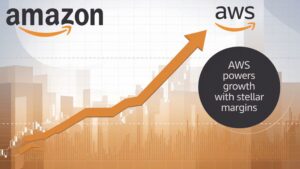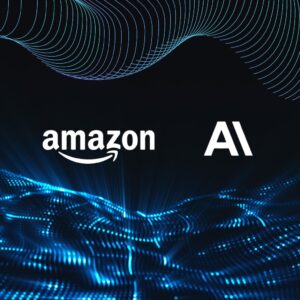Amazon’s AI Investment: How the Retail Giant Is Rewiring the Cloud, Chips, and the Future of Work
Amazon is no longer just the everything store. Over the last several years it has quietly — and then loudly — converted itself into one of the world’s biggest backers of artificial intelligence. That bet spans cloud services, custom silicon, large strategic investments in AI startups, university research grants, and a rapid productization push to put AI into every developer’s toolkit and every enterprise’s workflow. This article unpacks what Amazon is investing in, why it’s doing so, how those pieces fit together, and what it means for customers, competitors, and the broader AI ecosystem.
Executive summary
-
Amazon’s AI strategy is multi-pronged: build and sell AI infrastructure (AWS), design custom AI chips (Trainium/Inferentia/Graviton families), fund external AI innovation (direct investments and grants), and productize models and tools for enterprise adoption (Bedrock, Agent frameworks). Amazon Web Services, Inc.+1
-
The company has placed large, high-visibility bets, including multi-billion dollar investments in model companies (notably Anthropic) and hundreds of millions for research, university compute access, and agent development. Amazon News+1
-
Amazon’s vertical integration — from datacenter and chips to model marketplaces and agent orchestration — is designed to capture value across the full AI stack and to harden AWS’s position vs rivals.
-
The strategy creates meaningful upside (cost leadership, differentiated services) but also poses technical, customer-adoption, and regulatory challenges.
A quick timeline of Amazon’s major AI moves
-
Custom silicon: AWS has developed AI accelerators (Trainium for training; Inferentia for inference) and integrated them into EC2 instances designed to lower the cost-per-token and improve throughput for customers. Amazon Web Services, Inc.
-
Strategic investments in model makers: Amazon invested heavily in Anthropic, committing several billion dollars across multiple tranches — part of a broader move to ensure model supply, customer choice, and close product integration. Amazon News
-
University and research programs: Amazon launched programs to provide Trainium credits and research clusters to universities and researchers, injecting compute and funding into academic AI research. Amazon News
-
Productization and agent push (2024–2025): AWS expanded Bedrock and introduced agent frameworks and a corpus of agent tooling, while announcing targeted funding to accelerate agentic AI development. Amazon Web Services, Inc.Amazon News
-
Massive infrastructure commitments: Amazon continues to expand datacenter and cloud capacity globally — a necessary foundation for any large-scale AI play. (Regional infrastructure investments and multi-billion state deals continued through 2024–2025.) TechRadargovernor.nc.gov
Why Amazon is making these bets — three strategic pillars
1) Control the compute stack and reduce unit economics
Training and serving large models is computationally intense and expensive. By developing custom chips (Trainium for training workloads and Inferentia for inference), Amazon is trying to reduce the cost of running AI workloads on AWS and to control supply chain constraints related to third-party GPUs. If AWS can deliver better price-performance for customers, it gains market share and creates a sticky economics play: customers who optimize for the AWS chip ecosystem are more likely to stay. Amazon Web Services, Inc.
2) Secure model supply and differentiated product integrations
Large AI models and the companies behind them are now central to cloud platform value. Amazon’s multi-billion dollar investments in model makers (e.g., Anthropic) aren’t pure philanthropy — they are strategic: ensuring those models run primarily (or optimally) on AWS, integrating them deeply into Bedrock and other AWS services, and giving Amazon a veto or influence over future directions in model development. This reduces Amazon’s dependency on other clouds for the fastest-moving model innovation. Amazon News
3) Seed the ecosystem and accelerate real-world adoption
Beyond chasing hardware and models, Amazon is investing in the ecosystem that will actually build profitable AI businesses: universities, startups, and enterprise teams. Programs that provide compute credits, research clusters, grants, and innovation center funding accelerate the production of new models and applications that are optimized for AWS. This “fund the builders” approach helps populate AWS Marketplace, Bedrock, and the long tail of use cases that eventually translate into revenue. Amazon NewsAmazon Web Services, Inc.
Where Amazon is deploying capital — the main buckets
Custom AI chips and datacenter buildout
-
Trainium & Inferentia: AWS’s in-house chips are present across instance families tailored to deep learning training and inference. These chips are embedded into clusters and offered as managed infrastructure for customers who want lower costs or alternative hardware to NVIDIA. Amazon Web Services, Inc.
-
Datacenter expansion: Amazon’s enormous capex on datacenters — running into tens of billions — is the physical backbone for hostable, scalable AI services. This includes announced multi-billion dollar regional commitments tied to state and local economic deals. TechRadargovernor.nc.gov
Strategic minority investments and partnerships
-
Anthropic: Amazon doubled down on Anthropic, bringing substantial capital and a preferred cloud partnership that funnels model performance and customer usage onto AWS. These investments signal that Amazon isn’t just a hardware provider but wants to be a central node in the model ecosystem. Amazon News
Grants, research programs, and ecosystem funding
-
Build on Trainium / university credits: Amazon’s multi-million programs give universities and researchers access to Trainium clusters and credits to accelerate academic research into new model architectures and optimizations. This both enhances AWS’s reputation in the research community and helps build tools and models that run well on Amazon’s hardware. Amazon News
-
Generative AI Innovation Center and agent funds: AWS announced targeted funds (e.g., an additional $100M for agentic AI and innovation centers) to encourage enterprise use cases and startups to adopt AWS tooling for agent development. Amazon Web Services, Inc.Amazon News
The product stack: From chips to agents
Amazon’s approach tightly links hardware and software:
-
Compute layer: EC2 instances with Trainium/Inferentia provide optimized cores. This matters for cost-sensitive training and inference. Amazon Web Services, Inc.
-
Model marketplace & APIs: Bedrock offers managed access to multiple models (Amazon’s own and 3rd-party) so developers can pick the model that fits their needs and pay through AWS billing.
-
Agent frameworks & orchestration: The company is pushing agentic AI — systems that can plan, act, and execute multi-step tasks — by releasing toolkits, marketplaces for agent components, and funding that reduces the friction to build enterprise agents. Amazon News
This vertical integration is designed to let Amazon surface differentiated features — speed, cost, compliance controls, and enterprise integrations (identity, data pipelines, observability) — that companies are willing to pay for.
What the Anthropic investment signals (and why it matters)
Amazon’s multi-billion dollar relationship with Anthropic is a clear example of the new cloud-model dynamic: cloud providers are no longer simply neutral compute vendors; they can be strategic partners and (to some degree) co-owners of model builders.
-
Access and influence: The deal guarantees Anthropic preferential access to AWS compute and integration into AWS products, helping both parties: Anthropic gets scale and predictable infrastructure; Amazon gets models that are optimized to run on its stack. Amazon News
-
Competitive posture: By taking a substantial stake in a high-quality model provider, Amazon reduces the chance that a rival cloud will exclusively host a differentiating model — a defensive move as much as an offensive one.
-
Market signal: These investments signal to enterprise buyers that AWS is serious about generative AI not just as a feature but as a platform play.
However, strategic investments also carry risks: regulatory scrutiny (antitrust, preferential treatment), alignment challenges between investors and founders, and the technical friction of supporting multiple chip and software stacks across customers.
Strengths of Amazon’s approach
-
End-to-end control: Owning the stack lets Amazon optimize across hardware, software, and services in ways that third-party dependencies make harder.
-
Economies of scale: Amazon’s massive datacenter and manufacturing footprint can drive down unit costs for compute — critical in an industry where compute is a dominant component of model economics. TechRadar
-
Ecosystem play: By funding universities and start-ups and building marketplaces, Amazon builds a flywheel of developers and businesses who will design for AWS first. Amazon News
-
Enterprise positioning: AWS’s existing enterprise relationships, compliance tooling, and global infrastructure make it a natural choice for regulated industries that need both model capabilities and governance.
Weaknesses and headwinds
-
Developer friction vs NVIDIA/CUDA: NVIDIA’s CUDA ecosystem has years of momentum; migrating codebases to AWS’s Neuron or different toolchains is non-trivial. Internal AWS documents (reported by press) noted parity challenges, and customers have sometimes chosen NVIDIA hardware for smoother migrations. Business Insider
-
Customer preferences and multi-cloud: Many enterprises prefer multi-cloud strategies to avoid lock-in, reducing the leverage Amazon gains from vertical integration.
-
Talent competition: AI talent is finite and expensive; acquiring and retaining top researchers remains a battle with other giants and startups.
-
Regulatory risks: Large strategic investments in model builders raise potential questions about market concentration and competitive fairness.
For enterprises and developers: what to expect
-
More instance choices and price competition: Expect AWS to continue releasing hardware-optimized instances and price promotions to push adoption of Trainium/Infenrentia for both training and inference. Amazon Web Services, Inc.
-
Growing library of managed models and agent templates: Bedrock and agent frameworks will likely expand with plug-and-play components, making it easier for non-ML teams to build agentic workflows. Amazon News
-
Stronger university and research partnerships: Academic programs with Trainium credits will produce code, libraries, and models that are naturally tuned for AWS — good for cutting-edge research but something engineers will need to account for if they aim for cross-cloud portability. Amazon News
Macro implications: competition, innovation, and supply chains
Competition
Amazon’s strategy intensifies the cloud arms race. Microsoft, Google, and now Amazon are all offering differentiated stacks: models + cloud + enterprise tooling. The consequence: the next few years will see more cloud-model bundling and strategic investments between clouds and model shops.
Innovation
The ecosystem funding and university credits accelerate open research and experimentation. That’s good for the pace of innovation — but it also means that the fastest progress may be biased toward the stacks that gave that compute away.
Supply chains and geopolitics
Large datacenter projects and chip developments have geopolitical footprints. Regional investments (including tens of billions in new facilities) mean states and local governments will continue courting Amazon for jobs and infrastructure, while Amazon must manage local regulations, power demands, and physical security. TechRadargovernor.nc.gov
Risks to watch
-
Model lock-in and antitrust scrutiny: As clouds take stakes in models, regulators may probe whether preferential hosting or preferential access creates anti-competitive barriers.
-
Technical compatibility: If AWS’s software stack can’t match CUDA and developer expectations, adoption will lag despite price advantages. Business Insider
-
Overreliance on a few model suppliers: Heavy bets on a small number of model companies concentrate risk if those models fall behind or if the vendor’s incentives diverge from Amazon’s. Amazon News
Scenarios: how this plays out over the next 3–5 years
Baseline: steady advantage for AWS
AWS gradually wins customers by lowering costs with custom chips, expanding Bedrock, and making it easier to build agentic workflows. Strategic investments (e.g., Anthropic) pay off as models optimized for AWS differentiate the platform.
Upside: market consolidation and enterprise dominance
If Amazon solves migration friction and GPUs remain constrained, AWS could grow market share substantially, making it the default platform for enterprise AI deployments — particularly in regulated industries that value AWS’s compliance and global presence.
Downside: fragmentation and multi-cloud status quo
If toolchain migration remains hard and model suppliers stay multi-cloud or choose rivals, Amazon’s investments could largely benefit the broader ecosystem without delivering proportional gains in market share, turning its massive spend into defensive necessities rather than profit accelerants.
What competitors are watching (and doing)
-
Microsoft focuses on deep integrations with OpenAI and developer productivity across Microsoft 365 and Azure.
-
Google pushes vertically integrated stacks (TPUs, Vertex AI, Gemini models) and developer tooling grounded in its research leadership.
-
NVIDIA remains the hardware and software incumbent for many cutting-edge workloads and is expanding its software stack to make migration between clouds easier.
Amazon’s differentiator is its relentless focus on operationalizing AI for enterprise customers — the question is whether that focus will outpace developer inertia and rival innovation.
Conclusion: Amazon’s AI bet is a portfolio — not a single move
Amazon’s AI investment is best viewed as a diversified portfolio: chips, datacenters, model bets, research credits, and productized agent tooling. That breadth is both a strength and a complexity. It gives Amazon multiple levers to capture value if enough of those levers pull together — cost advantages from silicon, model integrations from investments, and demand generation from developer programs.
For enterprises and developers, the near term will mean more choices, better prices, and a richer set of managed services for generative and agentic AI — but also tougher decisions about portability, vendor lock-in, and where to build for the long run.
Amazon is laying the rails for the next era of computing. Whether the train runs on AWS’s silicon and models — or whether customers keep the flexibility to choose elsewhere — will be one of the defining cloud battles of the 2020s.
Sources and further reading (selected)
-
AWS Trainium: AWS documentation on Trainium chips and their role in AI training. Amazon Web Services, Inc.
-
Amazon’s investment and partnership with Anthropic: company announcement and coverage. Amazon News
-
Build on Trainium and university research credits program: AWS announcements and tech press coverage. Amazon News
-
AWS Generative AI Innovation Center and agent funding announcements. Amazon Web Services, Inc.Amazon News
-
Amazon datacenter spending and regional investment reporting. TechRadargovernor.nc.gov
https://bitsofall.com/zed-32-million-funding-deltadb-ai-collaboration/
Nvidia’s New Chip for China: What It Is, Why It Exists, and How It Could Reshape the AI Supply Chain







